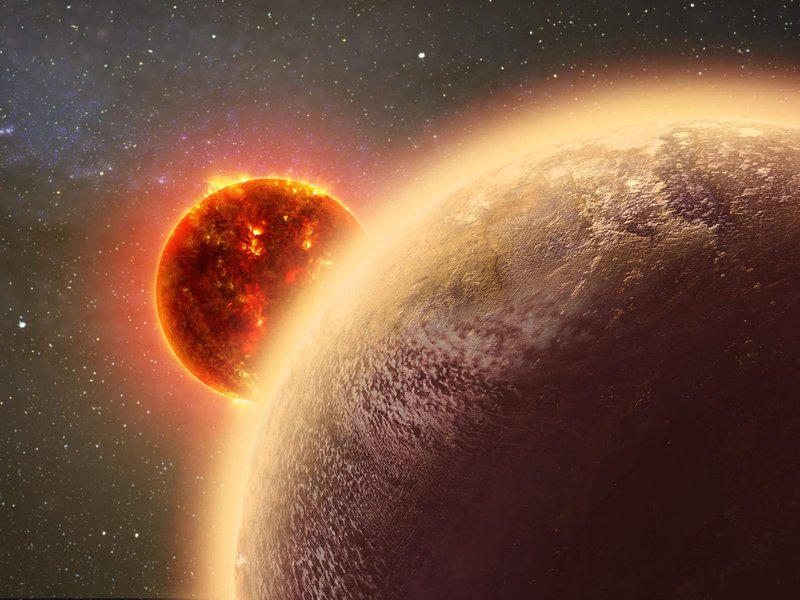Gliese 486b is a Hellish World With Temperatures Above 700 Kelvin
By Matt Williams
In the past two and a half decades, astronomers have confirmed the existence of thousands of exoplanets. In recent years, thanks to improvements in instrumentation and methodology, the process has slowly been shifting from the process of discovery to that of characterization. In particular, astronomers are hoping to obtain spectra from exoplanet atmospheres that would indicate their chemical composition.
This is no easy task since direct imaging is very difficult, and the only other method is to conduct observations during transits. However, astronomers of the CARMENES consortium recently reported the discovery of a hot rocky super-Earth orbiting the nearby red dwarf star. While being extremely hot, this planet has retained part of its original atmosphere, which makes it uniquely suited for observations using next-generation telescopes.
Part of the problem with characterizing exoplanets is that the ones considered most likely to be habitable are rocky exoplanets that orbit close to their stars. Any light reflected from their atmospheres and surfaces is therefore overpowered by the light of their parent star. As such, direct imaging is typically possible only where gas giants that have long orbits are concerned.

On occasion, astronomers are able to examine light passing through a planet’s atmosphere when it passes in front of its parent star (aka. transits). This also presents challenges, since rocky planets have comparatively thin atmospheres compared to gas giants (assuming they have any at all). As a result, many of the current atmospheric models for rocky planets remain untested.
Astronomers employed both Transit Photometry and Radial Velocity measurements – currently the two most effective methods (especially in combination) – to confirm the existence of Gliese 486b. This was done using data from Transiting Exoplanet Survey Satellite (TESS), the 1.52 m Telescopio Carlos Sánchez at the Teide Observatory, the Las Cumbres Observatory Global Telescope (LCOGT) network, and other instruments.
This latest planet discovered by the CARMENES consortium is known as Gliese 486b, a super-Earth that orbits an M-type (red dwarf) star located just 26 light-years away. This planet is roughly 2.8 times the mass of Earth, is similar in composition to Earth and Venus, and orbits 2.5 million km (1.55 million mi) from its star – roughly 1.6% the distance between Earth and the Sun – taking 1.5 days to complete an orbit.
Between its proximity to Earth, rocky composition, tight orbit with its parent star, and the fact that it has retained an atmosphere, this exoplanet satisfies all the requirements for follow-up observations by next-generation telescopes. Since Gliese 486b has a sidereal rotation that is the same as its orbital period (1.5 days), it is tidally-locked with its parent star (one side is always facing it).
Trifon Trifonov, a planetary scientist at the Max Planck Institute for Astronomy (MPIA) in Heidelberg, Germany, was the lead author on the research study. As he explained in a recent MPIA press statement:
“The proximity of this exoplanet is exciting because it will be possible to study it in more detail with powerful telescopes such as the upcoming James Webb Space Telescope and the future Extremely Large Telescopes.
“We can hardly wait for the new telescopes to become available. The results will help us to understand how well rocky planets can hold their atmospheres, what they are made of and how they influence the energy distribution on the planets.”
Even though Gliese 486 is a relatively faint and cool star (compared to the Sun), the amount of radiation it is exposed to is so intense that the planet experiences surface temperatures of up to 700 K (430 °C; 806 °F). From all of this, the surface of Gliese 486b is likely to look a lot like Venus, with a hot and dry landscape and crisscrossed by glowing rivers of lava.
One big difference, though, is that Gliese 486b appears to have a tenuous atmosphere (whereas Venus has an incredibly dense one). This is impressive considering that our current planetary models indicate that irradiation tends to strip planets of their gaseous envelopes. In this case, any atmosphere the planet still has would be retained by the super-Earth’s gravity.

As José A. Caballero of the Centro de Astrobiología (CSIC-INTA, Spain) and a co-author of the paper concluded:
“The discovery of Gliese 486b was a stroke of luck. A hundred degrees hotter and the planet’s entire surface would be lava. Its atmosphere would consist of vaporized rocks. On the other hand, if Gliese 486b were a hundred degrees colder, it would have been unsuitable for follow-up observations.”
In the future, the CARMENES team hope to observe Gliese 486b as it makes transits in front of its star (relative to us). It is at this point that small amounts of light will pass through the planet’s thin atmosphere, which will be detectable by observatories like James Webb. A second series of spectroscopic measurements will be conducted whenever Gliese 486b’s orbit takes it behind its star.
At this point, light reflected from the planet’s surface can be studied to obtain emission spectra. Between these two types of spectroscopic observations, astronomers will be able to field test the methods that will allow them to narrow the search for habitable planets. Ground-based observatories like the Extremely Large Telescope (ELT) and Giant Magellan Telescope (GMT) will also allow for direct imaging and spectroscopic studies.
The Calar Alto high-Resolution search for M dwarfs with Exoearths with Near-infrared and optical Échelle Spectrographs (CARMENES) consortium is made up of over 200 scientists and engineers from 11 institutions located in Spain and Germany. The study that describes their finding, “A nearby transiting rocky exoplanet that is suitable for atmospheric investigation,” recently appeared in the journal Science (Vol. 371, No. 6533).
Further Reading: MPIA, Science
The post Gliese 486b is a Hellish World With Temperatures Above 700 Kelvin appeared first on Universe Today.

March 9, 2021 at 04:21AM
via Universe Today read more...

Post a Comment